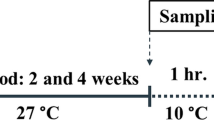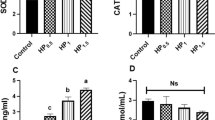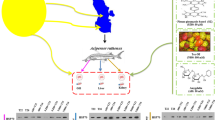Abstract
The nutritional selenium (Se) has been demonstrated to have health-boosting effects on fish. However, its effect on fish energy metabolism remains unclear. This study explores the effect and underlying mechanism of the action of nutritional Se on energy metabolism in fish. Rainbow trout (Oncorhynchus mykiss) were fed a basal diet (0 mg Se/kg diet) and a diet containing an already established nutritional Se level (2 mg Se/kg diet, based on Se-yeast) for 30 days. After the feeding experiment, the plasma and liver biochemical profiles and liver transcriptome were analyzed. The results showed that the present nutritional level of Se significantly increased liver triglyceride, total cholesterol, and plasma total cholesterol contents (P < 0.05) compared with the control. Transcriptome analysis showed that 336 and 219 genes were significantly upregulated and downregulated, respectively. Gene enrichment analysis showed that many differentially expressed genes (DEGs) were associated with lipid metabolism pathways (fatty acid biosynthesis, fatty acid elongation, and unsaturated fatty acid biosynthesis), carbohydrate metabolism pathways (glycolysis, the pentose phosphate pathway, and the citrate cycle), and the oxidative phosphorylation pathway. Real-time quantitative PCR (Q-PCR) validation results showed that the expression profiles of 15 genes exhibited similar trends both in RNA sequencing (RNA-seq) and Q-PCR analysis. These results reveal that optimum dietary Se activates glucose catabolic processes, fatty acid biosynthetic processes, and energy production and hence produces higher liver lipid content. This study concludes that the previously established level of nutritional Se (Se-yeast) (2 mg/kg diet, fed basis) for rainbow trout promotes energy storage in the liver, which may benefit fish growth to some extent.







Similar content being viewed by others
Data Availability
The data that support the findings of this study are available from the corresponding author upon reasonable request.
Code Availability
Not applicable.
References
Khan KU, Zuberi A, Fernandes JBK et al (2017) An overview of the ongoing insights in selenium research and its role in fish nutrition and fish health. Fish Physiol Biochem 43(6):1689–1705. https://doi.org/10.1007/s10695-017-0402-z
Lu J, Holmgren A (2009) Selenoproteins. J Biol Chem 284(2):723–727. https://doi.org/10.1074/jbc.R800045200
Lin YH, Shiau SY (2005) Dietary selenium requirements of juvenile grouper Epinephelus malabaricus. Aquaculture 250(1–2):356–363. https://doi.org/10.1016/j.aquaculture.2005.03.022
De Riu N, Lee JW, Huang SSY et al (2014) Effect of dietary selenomethionine on growth performance, tissue burden, and histopathology in green and white sturgeon. Aquat Toxicol 148:65–73. https://doi.org/10.1016/j.aquatox.2013.12.030
Wang KY, Peng CZ, Huang JL et al (2013) The pathology of selenium deficiency in Cyprinus carpio L. J FIsh Dis 36(7):609–615. https://doi.org/10.1111/jfd.12030
Holm J, Palace V, Siwik P et al (2005) Developmental effects of bioaccumulated selenium in eggs and larvae of two salmonid species. Environ Toxicol Chem 24(9):2373–2381. https://doi.org/10.1897/04-402r1.1
de Rosemond SC, Liber K, Rosaasen A (2005) Relationship between embryo selenium concentration and early life stage development in white sucker (Catostomus commersoni) from a northern Canadian lake. Bull Environ Contam Toxicol 74(6):1134–1142. https://doi.org/10.1007/s00128-005-0699-7
Al-Deriny SH, Dawood MAO, Elbialy ZI et al (2020) Selenium nanoparticles and spirulina alleviate growth performance, hemato-biochemical, immune-related genes, and heat shock protein in nile tilapia (Oreochromis niloticus). Biol Trace Elem Res 198(2):661–668. https://doi.org/10.1007/s12011-020-02096-w
Chris UO, Singh NB, Agarwal A (2018) Nanoparticles as feed supplement on growth behaviour of cultured catfish (Clarias gariepinus) fingerlings. Mater Today Proc 5(3):9076–9081
Khan KU, Zuberi A, Nazir S et al (2016) Effects of dietary selenium nanoparticles on physiological and biochemical aspects of juvenile Tor putitora. Turk J Zool 40(5):704–712. https://doi.org/10.3906/zoo-1510-5
Godin S, Fontagne-Dicharry S, Bueno M et al (2015) Influence of dietary selenium species on selenoamino acid levels in rainbow trout. J Agric Food Chem 63(28):6484–6492. https://doi.org/10.1021/acs.jafc.5b00768
Kohshahi AJ, Sourinejad I, Sarkheil M et al (2019) Dietary cosupplementation with curcumin and different selenium sources (nanoparticulate, organic, and inorganic selenium): influence on growth performance, body composition, immune responses, and glutathione peroxidase activity of rainbow trout (Oncorhynchus mykiss). Fish Physiol Biochem 45(2):793–804. https://doi.org/10.1007/s10695-018-0585-y
Kucukbay FZ, Yazlak H, Karaca I et al (2009) The effects of dietary organic or inorganic selenium in rainbow trout (Oncorhynchus mykiss) under crowding conditions. Aquacult Nutr 15(6):569–576. https://doi.org/10.1111/j.1365-2095.2008.00624.x
Chen YJ, Liu YJ, Tian LX et al (2013) Effect of dietary vitamin E and selenium supplementation on growth, body composition, and antioxidant defense mechanism in juvenile largemouth bass (Micropterus salmoide) fed oxidized fish oil. Fish Physiol Biochem 39(3):593–604. https://doi.org/10.1007/s10695-012-9722-1
Naderi M, Keyvanshokooh S, Ghaedi A et al (2019) Interactive effects of dietary nano selenium and vitamin E on growth, haematology, innate immune responses, antioxidant status and muscle composition of rainbow trout under high rearing density. Aquacult Nutr 25(5):1156–1168. https://doi.org/10.1111/anu.12931
Abd El-Kader MF, El-Bab AFF, Abd-Elghany MF et al (2021) Selenium nanoparticles act potentially on the growth performance, hemato-biochemical indices, antioxidative, and immune-related genes of european seabass (Dicentrarchus labrax). Biol Trace Elem Res 199(8):3126–3134. https://doi.org/10.1007/s12011-020-02431-1
Wang BK, Liu WB, Xu C et al (2017) Dietary carbohydrate levels and lipid sources modulate the growth performance, fatty acid profiles and intermediary metabolism of blunt snout bream Megalobrama amblycephala in an interactive pattern. Aquaculture 481:140–153. https://doi.org/10.1016/j.aquaculture.2017.08.034
Zhang WX, Sun SM, Ge XP et al (2018) Effects of dietary lipid sources on growth performance, fatty acid composition and hepatic lipid metabolism of juvenile blunt snout bream Megalobrama amblycephala. Aquac Nutr 24(6):1652–1663. https://doi.org/10.1111/anu.12800
Berntssen M, Sundal TK, Olsvik PA et al (2017) Sensitivity and toxic mode of action of dietary organic and inorganic selenium in Atlantic salmon (Salmo salar). Aquat Toxicol 192:116–126. https://doi.org/10.1016/j.aquatox.2017.09.014
Knight R, Marlatt VL, Baker JA et al (2016) Dietary selenium disrupts hepatic triglyceride stores and transcriptional networks associated with growth and Notch signaling in juvenile rainbow trout. Aquat Toxicol 180:103–114. https://doi.org/10.1016/j.aquatox.2016.09.014
Lee J, Hong S, Sun JH et al (2019) Toxicity of dietary selenomethionine in juvenile steelhead trout, Oncorhynchus mykiss: tissue burden, growth performance, body composition, hematological parameters, and liver histopathology. Chemosphere 226:755–765. https://doi.org/10.1016/j.chemosphere.2019.03.184
Li N, Zheng YH, Wu XF et al (2017) Tolerance of selenium-yeast in diets of largemouth bass (Micropterus salmoides). Chin J Anim Nutr 29(6):1949–1960
Mcphee DL, Janz DM (2014) Dietary selenomethionine exposure alters swimming performance, metabolic capacity and energy homeostasis in juvenile fathead minnow. Aquat Toxicol 155:91–100. https://doi.org/10.1016/j.aquatox.2014.06.012
Pettem CM, Briens JM, Janz DM et al (2018) Cardiometabolic response of juvenile rainbow trout exposed to dietary selenomethionine. Aquat Toxicol 198:175–189. https://doi.org/10.1016/j.aquatox.2018.02.022
Hilton JW, Hodson PV, Slinger SJ (1980) The requirement and toxicity of selenium in rainbow trout (Salmo gairdneri). J Ren Nutr 110(12):2527–2535
Hodson PV, Hilton JW (1983) The nutritional requirements and toxicity to fish of dietary and waterborne selenium. Ecol Bull 35:335–340. https://doi.org/10.2307/20112868
Wang L, Zhang DF, Li S et al (2021) Dietary selenium promotes somatic growth of rainbow trout (Oncorhynchus mykiss) by accelerating the hypertrophic growth of white muscle. Biol Trace Elem Res 199(5):2000–2011. https://doi.org/10.1007/s12011-020-02282-w
Fontagné-Dicharry S, Godin S, Liu HK et al (2015) Influence of the forms and levels of dietary selenium on antioxidant status and oxidative stress-related parameters in rainbow trout (Oncorhynchus mykiss) fry. Brit J Nutr 113(12):1876–1887. https://doi.org/10.1017/S0007114515001300
Pfaffl MW (2001) A new mathematical model for relative quantification in real-time RT-PCR. Nucleic Acids Res 29(9):e45. https://doi.org/10.1093/nar/29.9.e45
Pfaffl MW, Horgan GW, D L, (2002) Relative expression software tool (REST©) for group-wise comparison and statistical analysis of relative expression results in real-time PCR. Nucleic Acids Res 9:e36. https://doi.org/10.1093/nar/30.9.e36
Misra S, Peak D, Chen N et al (2012) Tissue-specific accumulation and speciation of selenium in rainbow trout (Oncorhynchus mykiss) exposed to elevated dietary selenomethionine. Comp Biochem Physiol C Toxicol Pharmacol 155(4):560–565. https://doi.org/10.1016/j.cbpc.2012.01.005
Tocher DR (2003) Metabolism and functions of lipids and fatty acids in teleost fish. Rev Fish Sci 11(2):107–184. https://doi.org/10.1080/713610925
Polakof S, Panserat S, Soengas JL et al (2012) Glucose metabolism in fish: a review. J Comp Physiol B 182(8):1015–1045. https://doi.org/10.1007/s00360-012-0658-7
Li YH, Zhang FF, Huang LJ et al (2020) Influence of dietary nano-selenium on growth, muscle composition, and serum biochemical and antioxidant indices of Schizothoraxprenanti. J Fish Sci Chin 27(6):682–691
Tavana BGZ, Banaee M, Jourdehi AY et al (2018) Effects of selenium (Sel-Plex) supplement on blood biochemical parameters of juvenile Siberian sturgeon (Acipenser baerii). Iran J Fish Sci 17(2):300–312. https://doi.org/10.22092/ijfs.2018.115481
Polakof S, Skiba-Cassy S, Choubert G et al (2010) Insulin-induced hypoglycaemia is co-ordinately regulated by liver and muscle during acute and chronic insulin stimulation in rainbow trout (Oncorhynchus mykiss). J Exp Biol 213(9):1443–1452. https://doi.org/10.1242/jeb.037689
Pacitti D, Lawan MM, Feldmann J et al (2016) Impact of selenium supplementation on fish antiviral responses: a whole transcriptomic analysis in rainbow trout (Oncorhynchus mykiss) fed supranutritional levels of Sel-Plex®. BMC Genomics 17. https://doi.org/10.1186/s12864-016-2418-7
Hu X, Chandler JD, Orr ML et al (2018) Selenium supplementation alters hepatic energy and fatty acid metabolism in mice. J Ren Nutr 148(5):675–684. https://doi.org/10.1093/jn/nxy036
Zhao Z, Barcus M, Jonggun K et al (2016) High dietary selenium intake alters lipid metabolism and protein synthesis in liver and muscle of pigs. J Ren Nutr 146(9):1625–1633. https://doi.org/10.3945/jn.116.229955
Yu QR, Fu ZQ, Huang MX et al (2021) Growth, physiological, biochemical, and molecular responses of Pacific white shrimp Litopenaeus vannamei fed different levels of dietary selenium. Aquaculture 535:12. https://doi.org/10.1016/j.aquaculture.2021.736393
Mueller AS, Pallauf J, Rafael J (2003) The chemical form of selenium affects insulinomimetic properties of the trace element: investigations in type II diabetic dbdb mice. J Nutr Biochem 14(11):637–647. https://doi.org/10.1016/j.jnutbio.2003.08.001
Chen HP, Qiu QQ, Zou C et al (2015) Regulation of hepatic carbohydrate metabolism by Selenium during diabetes. Chem Biol Interact 232:1–6. https://doi.org/10.1016/j.cbi.2015.02.017
Rich PR, Maréchal A (2010) The mitochondrial respiratory chain. Essays Biochem 47:1–23. https://doi.org/10.1042/bse0470001
Thirunavukkarasu C, Singh JPV, Selvendiran K et al (2001) Chemopreventive efficacy of selenium against N-nitrosodiethylamine-induced hepatoma in albino rats. Cell Biochem Funct 19(4):265–271. https://doi.org/10.1002/cbf.924
Stone DAJ (2003) Dietary carbohydrate utilization by fish. Rev Fish Sci 11(4):337–369. https://doi.org/10.1080/10641260390260884
Hemre GI, Mommsen TP, Krogdahl A (2002) Carbohydrates in fish nutrition: effects on growth, glucose metabolism and hepatic enzymes. Aquac Nutr 8(3):175–194. https://doi.org/10.1046/j.1365-2095.2002.00200.x
Funding
This study is supported by the National Key Research and Development Program (grant number: 2019YFD0900303) and the Fundamental Research Funds for the Central Universities (grant number: 2662021SPPY001 and 11900022414).
Author information
Authors and Affiliations
Contributions
Conceptualized and designed the experiments: Feifei Chen, Li Wang. Performed the experiments: Feifei Chen, Li Wang, Dianfu Zhang, Sai Li. Analyzed the data and interpreted results of experiments: Feifei Chen. Drafted the manuscript: Feifei Chen. Edited and revised the manuscript: Feifei Chen, Li Wang, Dianfu Zhang, Sai Li, Xuezhen Zhang. All authors approved the final version of the manuscript.
Corresponding author
Ethics declarations
Ethics Approval
This study was approved by The Scientific Ethic Committee of Huazhong Agricultural University (no. HZAUFI-2018–017).
Conflict of Interest
The authors declare no competing interests.
Additional information
Publisher's Note
Springer Nature remains neutral with regard to jurisdictional claims in published maps and institutional affiliations.
Supplementary Information
Below is the link to the electronic supplementary material.
Rights and permissions
About this article
Cite this article
Chen, F., Wang, L., Zhang, D. et al. Effect of an Established Nutritional Level of Selenium on Energy Metabolism and Gene Expression in the Liver of Rainbow Trout. Biol Trace Elem Res 200, 3829–3840 (2022). https://doi.org/10.1007/s12011-021-02953-2
Received:
Accepted:
Published:
Issue Date:
DOI: https://doi.org/10.1007/s12011-021-02953-2




